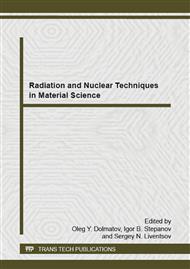p.313
p.317
p.322
p.327
p.333
p.338
p.342
p.349
p.352
Technology for Silicon NTD Using Pool-Type Research Reactors
Abstract:
Neutron transmutation doped silicon is an important material for electronics that is based on the conversion of 30Si into 31P through a 30Si (n,γ) → 31Si reaction taking place during the neutron irradiation and followed by the beta decay of 31Si into 31P. The production of such silicon requires high homogeneity. The paper describes a new facility for NTD of silicon ingots of up to 5 inches in diameter and presents the experimental results that were obtained at IRT-T research nuclear reactor.
Info:
Periodical:
Pages:
333-337
Citation:
Online since:
January 2015
Authors:
Keywords:
Price:
Сopyright:
© 2015 Trans Tech Publications Ltd. All Rights Reserved
Share:
Citation:


